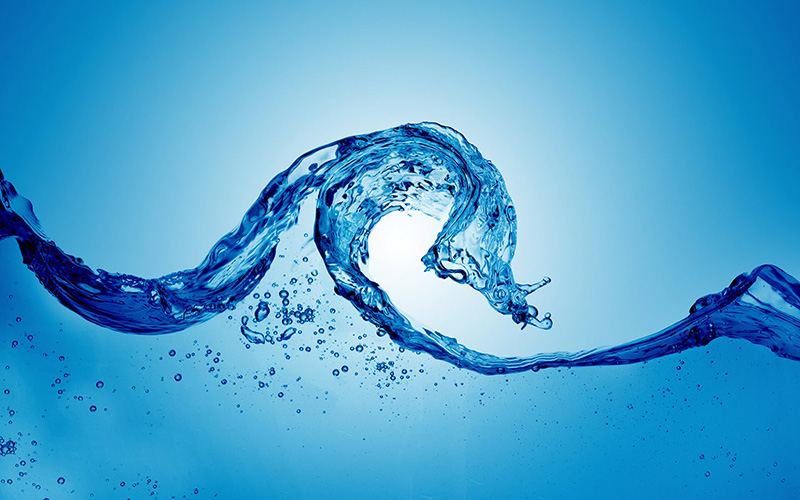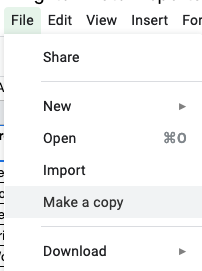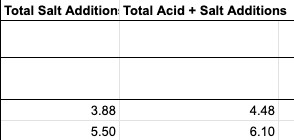
Brighton Brewing Water spreadsheet tutorial
Getting started
For those getting started brewing in Brighton, as well as those experienced looking for a simple reference for brewday using local tapwater, I’ve created Brighton water spreadsheet. As this is a read only spreadsheet, the first thing to do is to make a copy or download it, go to File, Make a Copy, or Download – and choose your format. The download button is just below Make a Copy.

(Advanced) You can also download the Bru’n Water spreadsheets I based my salt additions on here.
Though water treatment may look complicated, it’s actually pretty simple. You need to do 2 things: adjust the pH (acidity/alkalinity) of your mash, and add salts to the brewing liquor/water.
Adjusting the pH will help you get better efficiency, is better for yeast health and reduces astringency that can happen in mashes where the water pH is too high. If you’re brewing blonde or amber beers in Brighton, you absolutely MUST do this. As well as providing nutrients for the yeast (calcium and magnesium), salts will help change the mouthfeel of your beer – the big 2 are chloride (Cl) and sulphate (SO4). As well as absolute quantities, more importantly, you’re looking at the ratio between them. If sulphates are high and chlorides are low you’ll have a drier, more hop bitterness forward beer, if chlorides high/sulphates low – you’ll have a maltier, creamier beer. If they’re balanced, then the beer will be somewhere in the middle.
Instead of looking at city brewing water profiles, we’re going to be working from the 3 different profile categories from Bru’n Water for a number of base beer colours:
Dry: higher SO4 levels: drier, crisper, more hop bitter forward. Think a West Coast IPA, bitter, Burton pale. Balanced: similar SO4:Cl levels. Balance between malt and hop. Full: higher Cl levels: malt forward, creamy. Stouts, porters, NEIPA.
Bear in mind, some of the above attributes can be achieved through mashing (dry/full body), malt bills (oats/wheat for creamy texture) and other techniques. Your water profile should be a tool in your arsenal used in combination with manipulation of mashing and yeast that contributes towards the overall flavour of your beer.
Water data (sheet 1)

If you’re in Brighton and aren’t interested in the data part, you can ignore this and move to sheet 2 section. Just know that the figures I’m using to adjust the salts are highlighted in the green row.
I’ve collected water report data from various Brighton (and surrounds) sources. The green row is a trimmed mean of the Brighton reports (not Lewes or Worthing). The trimmed mean is a best approximation of our water profile, ignoring outliers like the Hove chloride report from April 16 (110ppm), which as you can see are mostly around 40ppm. Apparently Brighton water is taken from only a few different sources, all of which come from limestone aquifers, so unlike some other places, our water profile is going to be quite consistent.
If you’re in Worthing or Lewes, you can change the reference cells in the trimmed mean to reflect the data in those cells.
For Worthing for example:
=TRIMMEAN(C2:C9,0.5) becomes =TRIMMEAN(C11:C13,0.5)
(Advanced) You could also just enter your water report figures into the trimmed mean cells. If you’re feeling fancy, play around with those 0.5 figures, the lower the figure (say 0.2), the less of the outliers it’ll ignore, meaning that chloride figure is going to get further away from the 40 mark. If you put a higher figure, it’ll be more strict about excluding the outliers.
Salt Additions (Sheet 2)
Now we come to the heart of the matter.
In the interest of trying to make what seems like a complex subject on first approach a little more simple, if you’re new to brewing and water treatment, just look at steps 1-4 and ignore the advanced sections if they’re harder to understand.
We’ll use a simple brew as an example. We’re going to do a full mash (with no sparge water) of 25 litres. We’re making a West Coast IPA, we want a crisp hop bite for this beer.
Enter your brew volume in the Total Water (litres) cell down the bottom left of the sheet. I’ve entered 25 litres. If I wanted to treat sparge water, I’d just change it to e.g. 5 litres and use the levels shown for salts and acid.
 (Advanced) If you’re diluting with RO or bottled water like Ashbeck, you can add a dilution water profile and volume. Keep the total volume the same, just add what extra water you’re using. You’ll see those figures on the bottle of water you’re using, or just enter 0 for RO.
(Advanced) If you’re diluting with RO or bottled water like Ashbeck, you can add a dilution water profile and volume. Keep the total volume the same, just add what extra water you’re using. You’ll see those figures on the bottle of water you’re using, or just enter 0 for RO.Choose your profile/style. Our West Coast IPA is a light blonde beer, and is going to need a hoppy kick, so yellow dry is the right profile. Don’t worry about a/b, I’ll come to that next, just choose a profile for the time being.

(Advanced) There are a lot of town/city profiles (London, Dublin, Munich) knocking about, but they’re not super helpful when you’re getting started out in brewing, stick to the profiles here till you learn a bit more about water treatment. TIP: If you want to replicate a water profile from a geographical style, try and match the salt profile, and not the bicarbonates.
Choose your acid/dose.

The rows are interchangeable, just choose lactic OR phosphoric acid. Use the bold figure in the white cells for your total dosage. I’m going with the Murphy Total for lactic acid as I know it works well with blonde beers, so 15ml of lactic acid. I’ve included Murphy (higher) and Bru’n Water suggested dose for lactic acid as I’ve found my water responds better to higher lactic acid doses for blonde beers.
Choose either gypsum/calcium chloride or epsom salt/table salt. I’ve used those somewhat abritrary pairings for simplicity’s sake and I wanted a quick reference with limited options.

The top row (a) gives you gypsum/CaCl salt additions for 25 litres of liquor: 3.75g of epsom salt and 0.125g of calcium chloride. I’m going to use the next row (Epsom/table salt) and add 5.25g of Epsom salt and 0.25g of table salt, as it gives a little more magnesium and a little less calcium. Both of these would work absolutely fine, but would give slightly different salt profiles. If you’re using table salt, try to use something without anti-caking agent or iodine – like Kosher salt.
YOUR TOTAL WATER TREATMENT ADDITIONS:
– 15ml lactic acid
– 5.3g of epsom salts
– 0.3g of kosher saltThat’s it! That’s all you need. All this, for that tiny 20g or so of stuff that goes into 25kg of water. Trust me, it’ll be worth it. You can buy me a beer later.
Advanced Info For Keen Students

If you want to mix and match the salts (i.e. use different pairs or more than 2 salts), it’s not a problem. Easiest way is to probably copy the row, that way you don’t lose any of the preset salt additions.
Just make sure that the result profile SO4/Cl cells are green (see the image above) when you’ve finished tweaking your salts, that way you’ve matched up the cells with the Target Profile SO4/Cl cells.
You could also add your own personal target salt profile here if you didn’t want to jump to another spreadsheet to do that. I’ve not included the HCO3 section as it’s not important for profile matching.

To give you a more visual display of the information, the ratio between the SO4 and Cl will change the colour of the Ratio column cells. Red is dry, amber balanced, yellow full. This may help give you some visual feedback if you’re adding your own custom profiles.

I’ve also included for reference, the total salt/acid additions for the profile. Generally waters suited to brewing a particular style without any treatment will have a lower figure in both of these columns. Amber and blonde dry beers have over 6g/ml additions, whereas black/full have under 1g/ml additions.
We can conclude from these different totals, that if you’re not treating your water in Brighton, you’ll be better off brewing a dark/full beer than a blonde/dry beer. This fits in with personal experience. If you choose not to treat your water, your dark beers will be MUCH better than your light beers. In fact, I’d go so far as to say: DON’T brew blonde beers here without water treatment, your friends will thank you for it, or will be very polite by not telling you the truth about them!